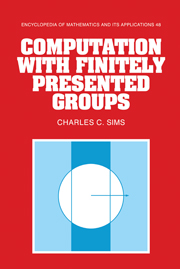Book contents
- Frontmatter
- Contents
- Preface
- Introduction
- 1 Basic concepts
- 2 Rewriting systems
- 3 Automata and rational languages
- 4 Subgroups of free products of cyclic groups
- 5 Coset enumeration
- 6 The Reidemeister-Schreier procedure
- 7 Generalized automata
- 8 Abelian groups
- 9 Polycyclic groups
- 10 Module bases
- 11 Quotient groups
- Appendix Implementation issues
- Bibliography
- Index
Preface
Published online by Cambridge University Press: 06 March 2010
- Frontmatter
- Contents
- Preface
- Introduction
- 1 Basic concepts
- 2 Rewriting systems
- 3 Automata and rational languages
- 4 Subgroups of free products of cyclic groups
- 5 Coset enumeration
- 6 The Reidemeister-Schreier procedure
- 7 Generalized automata
- 8 Abelian groups
- 9 Polycyclic groups
- 10 Module bases
- 11 Quotient groups
- Appendix Implementation issues
- Bibliography
- Index
Summary
In 1970, John Cannon, Joachim Neubüser, and I considered the possibility of jointly producing a single book which would cover all of computational group theory. A draft table of contents was even produced, but the project was not completed. It is a measure of how far the subject has progressed in the past 20 years that it would now take at least four substantial books to cover the field, not including the necessary background material on group theory and the design and analysis of algorithms. In addition to a book like this one on computing with finitely presented groups, there would be books on computing with permutation groups, on computing with finite solvable groups, and on computing characters and modular representations of finite groups.
Computational group theory was originated by individuals trained as group theorists. However, there has been a steadily increasing participation in the subject by computer scientists. There are two reasons for this phenomenon. First, group-theoretic algorithms, particularly ones related to permutation groups, were found to be useful in attacking the graph isomorphism problem, a central problem in theoretical computer science. Once computer scientists began looking at group-theoretic algorithms, it was natural for them to attempt to determine the complexity of these algorithms. Second, the techniques and data structures of computer science have proved valuable in improving existing group-theoretic algorithms and in developing new ones.
This book is intended to be a graduate-level text. I have made a deliberate attempt to make the material accessible to students of both mathematics and computer science.
Information
- Type
- Chapter
- Information
- Computation with Finitely Presented Groups , pp. xi - xivPublisher: Cambridge University PressPrint publication year: 1994
